Racial/Ethnic-Specific Reference Intervals for Common Laboratory Tests: A Comparison among Asians, Blacks, Hispanics, and White
- PMID: 26468426
- PMCID: PMC4578165
Racial/Ethnic-Specific Reference Intervals for Common Laboratory Tests: A Comparison among Asians, Blacks, Hispanics, and White
Abstract
Reference intervals (RIs) for common clinical laboratory tests are usually not developed separately for different subpopulations. The aim of this study was to investigate racial/ethnic differences in RIs of common biochemical and hematological laboratory tests using the National Health and Nutrition Examination Survey (NHANES) 2011-2012 data. This current study included 3,077 participants aged 18-65 years who reported their health status as "Excellent," "Very good," or "Good," with known race/ethnicity as white, black, Hispanic, or Asian. Quantile regression analyses adjusted for sex were conducted to evaluate racial/ethnic differences in the normal ranges of 38 laboratory tests. Significant racial/ethnic differences were found in almost all laboratory tests. Compared to whites, the normal range for Asians significantly shifted to higher values in globulin and total protein and to lower values in creatinine, hematocrit, hemoglobin, mean cell hemoglobin, mean cell hemoglobin concentration, and mean platelet volume. These results indicate that racial/ethnic subpopulations have unique distributions in the labortoary tests and race/ethnicity may need to be incorporated in the development of their RIs. Establishment of racial/ethnic-specific RIs may have significant clinical and public health implication for more accurate disease diagnosis and appropriate treatment to improve quality of patient care, especially for a state with diverse racial/ethnic subpopuations such as Hawai'i.
Keywords: NHANES; Race/ethnicity; laboratory test; reference interval; sex.
Figures

References
-
- Ash KO, Clark SJ, Sandberg LB, Hunter E, Woodward SC. The influences of sample distribution and age on reference intervals for adult males. Am J Clin Pathol. 1983 May;79(5):574–581. - PubMed
Publication types
MeSH terms
Grants and funding
LinkOut - more resources
Full Text Sources
Other Literature Sources
Medical

